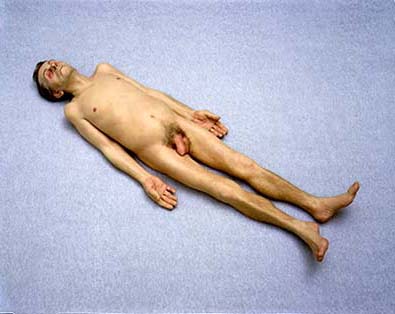As Oscar Wilde famously remarked, “Children begin by loving their parents. After a time they judge them. Rarely, if ever, do they forgive them.” It would be interesting to know where Ron Mueck was, on the Wildean scale of filial emotions, when he made his best known sculpture, Dead Dad. Mueck himself seems a little unsure but he remembers that the work – a silicone and acrylic simulacrum of the naked body of his recently deceased father – took him several months and great pains.
Getting the colour of a day-old corpse exactly right was hard enough, but it was the more minute detail that really took the time. Each individual hair had to be punched in by hand. Then, one day, it was done. There he lay, the father figure suddenly drained of life, as if on the mortician’s slab. There it was, the memory of a parent, fused with the fact of his death – all encapsulated in a disconcertingly realistic image, flesh but not flesh, like a higher form of waxwork. No detail had been overlooked. The body stiff with rigor mortis. The face, drawn and grey, a little pink seepage around the eyes. The stubbled chin. The swollen stomach, stretched over a barely visible network of veins. The flaccid penis (“roseate cock with its prepuce folded close like a link of cold sausage”, as the poet Craig Raine later put it, in a remarkable hymn of admiration for Mueck’s work published in the magazine Modern Painters). The helpless outstretched palms. The skinny, slightly wasted legs. The calloused yellow soles. Dead Dad, as dead as dead could be.
Why would anyone want to create such a thing? “It was just a way of thinking about my dad, really, a way of saying...


